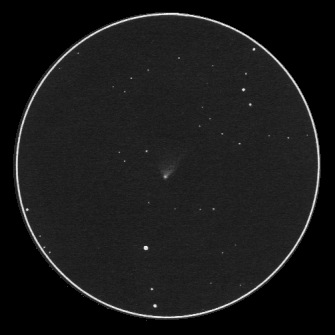
Hubble’s Variable Nebula NGC 2261
Sketch by Kiminori Ikebe, text by Frank McCabe
As can be seen in Kiminori Ikebe’s excellent sketch, the Hubble variable nebula is an example of a cometary reflection nebula associated with a bright protostar known as R Monocerotis. R Monocerotis is a large, young, hot binary surrounded by a close in orbiting dust and molecular gas cloud that is common to stars that are massive and entering the main sequence. Beyond the close in orbiting gas and dust is a larger, empty paraboloid shaped gas and dust cloud we see as the visible nebula with R Mon. occupying the vertex. This region extends out nearly 1 light year from the illuminating protostar. The nebula variability is due to shadows cast upon on the visible nebula created by irregularities in density of the orbiting inner gas and dust clouds which are cutting off some starlight. Variability can be detected in time intervals of weeks and months. It is fascinating to watch the shape and brightness of NGC 2261 as it varies over time. The nebula measures 2′ x 4′ in size and can change by 2 magnitudes or more in brightness.
Sketching:
Date: 2002.12.14 02:26
Telescope 32 cm. at 150x
Object Location: Constellation Monoceros
R.A.: 6h 39.2m Dec. : +08: 44′
Sketching Location: Kyushu, Japan

Kiminori,
Nice sketch of the very interesting object. Veriable Nebula is rare object!
Marek
ps. Good story Frank.